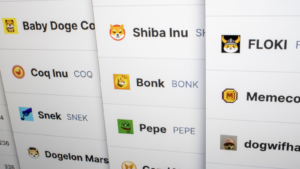Bitcoin’s (BTC-USD) price has been on an absolute tear lately as we approach the much-anticipated halving in April. The flagship cryptocurrency is up more than 114% over the past year, recently hitting 24-month highs. With the Securities and Exchange Commission approving several spot Bitcoin ETFs and more institutional money flowing into this asset class, it seems Bitcoin’s rally may just be starting.
Bitcoin’s built-in scarcity makes it an intriguing potential store of value, almost like “digital gold” for the digital age. The upcoming halving cuts the Bitcoin miners’ block rewards in half (and thus the token’s incoming supply). This could create a supply shock that sends Bitcoin stratospheric.
While Bitcoin garners much of the attention in this space, and rightfully so, savvy crypto investors know smaller altcoins can deliver truly outsized returns during bull runs. The last major run-up in late 2020 saw many altcoins deliver returns well over 1,000%!
Of course, with bigger potential rewards comes bigger risks. Altcoins remain extremely volatile and highly-speculative assets. I only recommend investing money you can afford to lose. Still, for those with some risk tolerance, I’ve compiled three altcoins I believe are undervalued heading into the upcoming halving.
SwissCheese (SWCH-USD)

At first glance, SwissCheese (SWCH-USD) may look like another meme coin thanks to its quirky name. But don’t let that fool you. This project has real substance and utility that could make it one of the most sought-after cryptos once word spreads.
SwissCheese aims to democratize trading and investing by enabling fractional ownership of stocks through tokenized representations on its decentralized platform. Users can access these fractional stocks through any digital token, cryptocurrency, or the native SWCH token. Each tokenized asset essentially represents a slice of an underlying stock.
This concept blows open stock market investing for those currently blocked by borders, regulations, or lacking payment options. Crypto knows no borders, so accessing U.S. stocks becomes far easier from abroad using SwissCheese’s platform. Decentralization also brings privacy benefits, which will appeal to many crypto enthusiasts.
As I write this, SwissCheese’s market capitalization sits at just $6.4 million. That said, the project’s total addressable market here could be enormous, given the platform’s global appeal and ability to tap into crypto hype. If SwissCheese gains even modest traction, its tiny valuation today could translate into 10x or 20x returns (or higher) ahead. That asymmetric risk-reward looks compelling to me.
Alephium (ALPH-USD)

Alephium (ALPH-USD) has been skyrocketing lately, joining the ranks of red-hot layer 1 blockchain projects. It competes directly against names like Kaspa (KAS-USD), Sei (SEI-USD), and others, but still sports a reasonable $190 million market cap at the time of writing.
This sharded blockchain platform focuses on delivering scalability, security, and energy efficiency to power the next generation of Web3 and decentralized applications.
From a tech perspective, Alephium uses a UTXO model and a unique Proof-of-Less-Work consensus that improves on Bitcoin’s pioneering protocol. It also boasts a custom virtual machine and tooling to support developers building on Alephium.
Over the past year, we’ve witnessed immense speculation and interest around ambitious layer 1 chains. Just look at Kaspa’s parabolic rally.
Alephium offers a similar value proposition – yet trades at a fraction of its competitors’ valuations. Given the massive room for additional upside, I wouldn’t be surprised if ALPH enters the ranks of 10-figure market cap cryptos.
Layer 1 protocols like Alephium offer ideal asymmetric upside for investors with a higher risk tolerance. Current prices seem inexpensive if Alephium can indeed evolve into a premium smart contract blockchain.
PAAL AI (PAAL-USD)

At the intersection of two red-hot trends – AI and crypto – sits PAAL AI (PAAL-USD). This chatbot project uses artificial intelligence and machine learning and integrates these technologies within its network.
PAAL AI also incentivizes its community by rewarding users with native tokens. PAAL tokens play governance and staking roles – or can unlock premium features.
We’ve witnessed the explosion of interest and adoption around AI chat tools like ChatGPT in recent months. I believe it’s only a matter of time before blockchain-based AI projects like PAAL also grab investor attention. That’s especially true given the synergy with crypto’s emphasis on computing power, decentralized networks, and community reward systems.
Consider Render Network (RNDR-USD), which allows users to monetize or access GPU power to run intensive computing tasks. Or proof-of-work chains that rely on miners contributing hardware for security and rewards. As blockchain platforms grow more advanced, I suspect we’ll see far more collaboration and interplay with AI as well.
PAAL’s current market price suggests this token may be relatively inexpensive, if we continue to see surging interest in both AI and crypto. With the recent breakout to new highs and a current market capitalization of $176 million, PAAL AI offers sizable upside potential if adoption scales up in 2024 and beyond.
On Low-Capitalization and Low-Volume Cryptocurrencies: InvestorPlace does not regularly publish commentary about cryptocurrencies that have a market capitalization less than $100 million or trade with volume less than $100,000 each day. That’s because these “penny cryptos” are frequently the playground for scam artists and market manipulators. When we do publish commentary on a low-volume crypto that may be affected by our commentary, we ask that InvestorPlace.com’s writers disclose this fact and warn readers of the risks.
Read More: How to Avoid Popular Cryptocurrency Scams
On the date of publication, Omor Ibne Ehsan did not hold (either directly or indirectly) any positions in the securities mentioned in this article. The opinions expressed in this article are those of the writer, subject to the InvestorPlace.com Publishing Guidelines.

